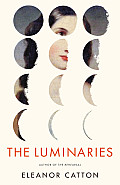 I’m not usually au courant in my reading, but lately I’ve been on top of things, and here’s another example. The Luminaries by Eleanor Catton took the 2013 Booker, and a guy can’t get much more right there than that. I don’t know if there’s been another Kiwi Booker, but you’ll get no argument from me about whether The Luminaries deserved it.
I’m not usually au courant in my reading, but lately I’ve been on top of things, and here’s another example. The Luminaries by Eleanor Catton took the 2013 Booker, and a guy can’t get much more right there than that. I don’t know if there’s been another Kiwi Booker, but you’ll get no argument from me about whether The Luminaries deserved it.
I’m usually irritated, sometimes enraged, by authors who withhold or manipulate plot and character information for their own tale-telling effects. Such things should emerge organically from the story, and when they don’t, when you see the hand of the author-as-god reaching into the fictive dream, it’s disruptive and maddening. It’s almost a rule to me that you need the little man to stay behind his screen. All of which goes to show the idiocy of making rules. There’s always an artist comes along to invalidate them.

Catton assumes the persona of a 19th century omniscient narrator here, complete with “in which” passages at the beginning of each chapter. Appropriate for a novel set in the 1860’s during the New Zealand gold rush. (Did you know there was a New Zealand gold rush? Not me, and as a CA historical novelist, I think I probably should have. Shame.) She moves us around in time and place according to her own whims and fancies, revealing a bit of action and character here, another bit there, then returning to the present then back again. And I was content–no, thrilled–to let her have her way and swim along in the dream, delighted and intrigued. Her choices about the what, when, and where of her narrative could be explained astrologically, as she implies in a preface which refers to her “faith in the vast and knowing influence of the infinite sky.” She provides us not with a “cast of characters” but a “Character Chart,” which places each character in a “Stellar” or a Planetary” category, gives them a “Related house” (a physical building from the story). Several characters come under a “Related Influence,” something I don’t understand. She meticulously labels each chapter with planetary descriptions, and I suspect research (which I am neither qualified nor inclined to do) would show lunar influences on character and plot. That is, after all, the conceptual meaning behind the title, and the novel indeed tells the story of star (moon and planetary?)-crossed lovers, though that doesn’t become clear till quite late in the story. And so, at last, on to that story.
One evening, Walter Moody walks off the boat that lands him in Hokitika, New Zealand and into the Crown Hotel. A dozen men are gathered in the smoking room to, as it eventually turns out, to share their perceptions of a story, an experience in which each of them has had a part, but of which none knows the whole. They select Moody, the outsider-newcomer, as a kind of arbiter, since each of the twelve has a large stake in the outcome.
A man has been found dead, apparently of alcoholism, in an isolated cabin. A large amount of gold, gold of unknown origin, is there with him. Some of the men knew him, some not. There are numerous contradictory clues and explanations about the source of the gold and its fair distribution. A local prostitute was found unconscious on the road near the cabin. She had no known involvement with the man or with the incident, but was heavily under the influence of opium and was a known addict.
As each man tells his part of the story and offers his speculations, we are carried hither and yon through time and space, often forgetting about the hotel gathering entirely as we get caught up in the thread of the current narrative. Clues about the gold, the death, and other matters get dropped, discredited, confused. We’re loving the story, fascinated by the characters, trying to put it all together. Then suddenly we learn something new that, alternately, doesn’t seem to fit or seems to explain everything, then suddenly fits after all or seems irrelevant to anything.
Eventually, of course, the Crown Hotel gathering breaks up. Nothing has been solved. Mysteries abound. We know a great deal more about each man, and, because Catton is a true 19th century omniscient, we know a great deal more about what each man is hiding. Somehow, magically, throughout this dense and densely-populated narrative, our interest never flags. The woman knows her moon, stars, and planets, and they pull us along every second. Then, finally, just when it seems the climax is near, when all will be revealed, she whirls us back to the beginning of it all. The “in which” headings to each chapter become as long as or sometimes longer than the chapter that follows, and we’re left . . . well, I won’t spoil it by telling you except to say I doubt any of those 19th century omniscients ended things exactly the way Catton does. However, I doubt any of them had her communion with her “infinite sky.” I would love another trip through her universe and hope she’s working hard on another vehicle for us to ride on.
